Are you planning to buy a dishwasher? Are you in confusion about various technical terms of dishwashers? Then this Dishwasher Buying Guide is for you to solve all your doubts.
In the past few years, the home has become a mere resting place for tired bodies after a long day of slogging.
In such a scenario, home appliances have achieved a huge level of importance in our lives.
When we think of Indian households, we imagine that there would be a woman to handle all the possible chores.
What if the woman herself is a working woman? And is it not really the responsibility of every family member to take care of the household?
This is where a dishwasher is bound to come to your rescue! It is not only a more hygienic option but also it is something that will reduce the time that is usually taken up by such tasks.
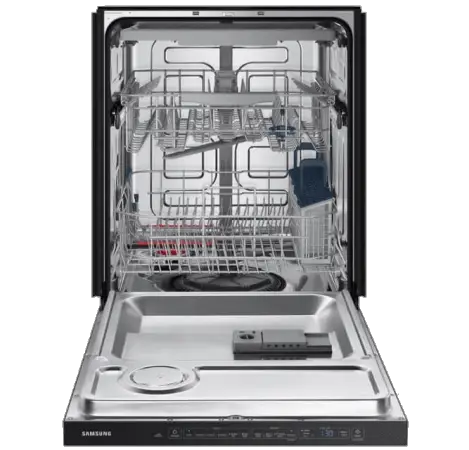
A dishwasher can easily be your best friend. However, choosing the right dishwasher can be nothing short of a terrible nightmare.
So many brands, so many products, and so many specifications. Sometimes it might turn out to be a very baffling experience. The best dishwasher in India is not really very easy to choose and buy.
The fact remains that the basis of each Indian household is good food and lots of it. The more the amount of food, the more will be the number of dirty utensils. Also, A family that eats together stays together.
So it is a family, extended family, and a lot of other guests whenever there is a party or a gathering. Can you then imagine the pile of plates you will have at your sink at the end of the day?
Are parties really meant to be so hard on you? The answer is no! All you need is a perfect dishwasher to solve your problems. It not only lists out the best dishwashers in India.
Here, one could ask why one should at all spend money on buying a machine that does what we could easily do manually.
The best dishwasher in India will save you physical work hours and significantly reduce the amount of stress on you that comes from the sheer weight of doing the chores.
This article is a Dishwasher buying guide for all of you out there. It will bring all your dishwasher-related requirements and inquiries to your fingertips as easily as that.
Types Of Dishwasher
There are mainly two types of a dishwasher based on how it is assembled in a kitchen.
- Built-In Dishwasher
- Portable Dishwasher
Built-In Dishwashers are further divided into the following two types.
- Standard Built-In Dishwasher
- Dishwasher Drawers
Portable Dishwashers are further divided into the following two types.
- Countertop dishwasher
- Portable on wheels
Built-In Dishwasher
Built-In Dishwasher can be installed under the sink and perfectly blends with the cabinet. The water connection and power connection also need to be done under the sink. With this, you won’t see any pipes or wires dangling around in the kitchen.
A built-in dishwasher is perfect if you buy a new house and design your kitchen cabinet considering your dishwasher size. After-market fitment is not good for built-in dishwashers.
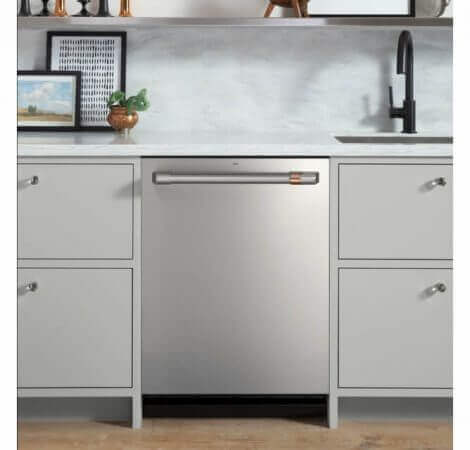
The maintenance and troubleshooting are a big pain for the built-in dishwasher as those are assembled under the sink.
However, because it keeps your kitchen clutter-free, many people prefer to choose a Built-In dishwasher due to its elegance and looks.
Built-in dishwashers do not come with any cover on top of the tub. So if you plan to use a built-in dishwasher as a portable dishwasher, you can not do that.
Dish Drawers
Dish drawers are not yet popular in India. It is similar to built-in dishwashers, but it has drawers instead of pull-down doors. The capacity of dish drawers is less than built-in dishwashers.
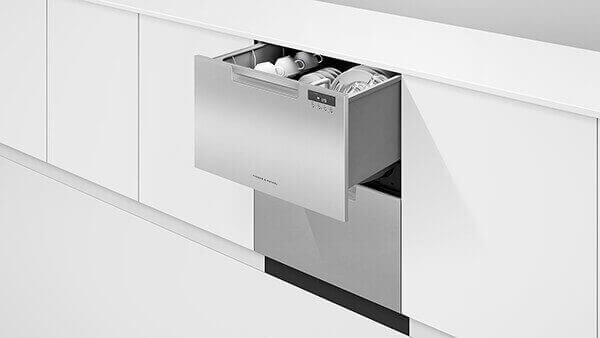
There are two types of dish drawers. One is the single-dish drawers, and the other is the double-dish drawers. NewZealand based company Fisher and Paykel initially introduced dish drawers, and now almost all the dishwasher companies manufacture dish drawers.
Counter Top Dishwasher
As the name suggests, a countertop dishwasher can be placed on top of your kitchen counter. You need to keep the dishwasher near the sink and connect the inlet to the faucet. This type of dishwasher occupies more space on the kitchen counter.
The capacity of countertop dishwashers is less than other types of dishwashers. The reason is that you can not keep a full-size dishwasher on top of a kitchen counter.
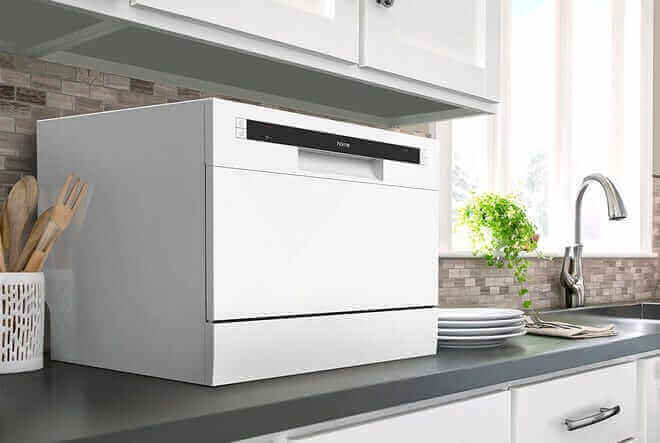
Countertop dishwashers are good if you are a bachelor or have a small family and staying in a rented place. You can move your dishwasher easily when you move to a new place.
Portable On Wheels
This is the best solution if you want to buy a dishwasher and place it wherever you want. Like how you put a washing machine on wheels and move it wherever you want, the same thing you can do with a portable wheels dishwasher.
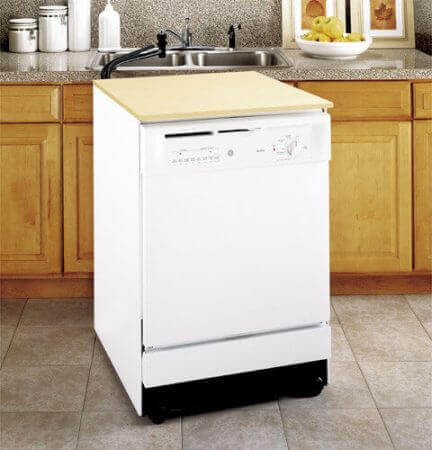
Portable wheel dishwashers have the same size and capacity as built-in dishwashers. You can keep the dishwasher in the kitchen, or you can keep it in the utility areas. Due to this added convenience, most consumers in India prefer to buy this type of dishwasher.
How Does Dishwasher Work?
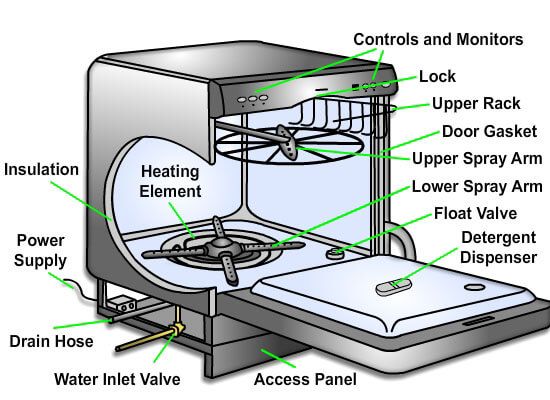
Here are the basic tasks a dishwasher does to clean dishes.
- Add water to the tub
- Heating the water
- Automatic dispensing of detergents
- The spray of water on dishes
- Drain the dirty water
- Fill the tub again for rinsing
- Drain out the irrigated dirty water
- Heated Dry
When you start a wash cycle in a dishwasher, the first thing it does is fill the tub with water. For that, you need to connect the inlet to the faucet, or you can have a separate water connection arrangement for the dishwasher.
Unlike washing machines, you can not put water into the dishwasher using buckets.
Water won’t fill the whole inside area of the dishwasher. Water only accumulates under the bottom area of the lower rack. There is a flood switch that detects the amount of water in the dishwasher.
Once the optimum water level is reached, the flood switch automatically stops the inlet valve and stops water from entering the dishwasher.
Once the water is in the tub, heating elements heat the water to 130-140 °F. Heating of water is needed to clean the dishes properly and also to sanitize them.
There is a sensor that detects the water temperature. Once the required temperature is reached, it stops the power to the heating element.
The hot water is then sprayed on the dishes through spray arms. There are numerous holes in those arms for pouring water.
Those arms are designed in such a way that they rotate by themselves due to the water pressure when it sprays out the water. If there are three racks in a dishwasher, there will be two spray arms.
After the wash, the dirty water gets drained away, and freshwater starts getting into the dishwasher for rinsing operation.
After the rinsing, again the dirty water gets drained away. But after the rinsing, a sensor checks how dirty the water is.
If the sensor detects that the water is not very dirty, it proceeds with the drying operation. Otherwise, it starts the washing cycle again until the sensor detects clean water.
Once the sensor detects clean water, it throws that water out and starts the drying operation. During the drying operation, the heating element generates heat.
Due to the heat, vapors get formed and go out of the dishwasher through vents. Once the drying operation is completed, the machine automatically stops with a beep sound to alert you that the dish cleaning is completed.
Factors to consider while buying a dishwasher: Dishwasher Buying Guide
Firstly, you have to remember that the dishwasher is no longer a rich man’s machine. It has become a necessity now.
So, you have to figure out your requirements before you are heading for buying a dishwasher. Here are a few factors that you should always consider before you buy a dishwasher.
1. Family Size
A lot of things depend on your family size when you buy a dishwasher. If you have more family members, you need to buy a dishwasher having a higher capacity or be ready to run your dishwasher multiple times a day to clean all your dishes. With that, you will be wasting a lot of your time and electricity. The choice is yours.
Every manufacturer mentions dishwasher capacity in their listings. The place setting defines dishwasher capacity.
Usually, you will find place settings in the range of 8,12,14, or 16. To give an idea, 1 place setting can hold a large dinner plate, a small snack plate, a saucer, a bowl, a coffee cup, a drinking glass, a knife, two teaspoons, a dinner fork, and a small salad fork. Now you have to decide what place setting you want to buy based on your family size.
For a typical family, 12 12-place setting dishwasher is more than enough. However, for a big joint family ( More than six members), consumers can go to 16 place settings.
However, 16 place-setting dishwashers are not very common in the Indian market. Below is an excellent video explaining what is meant by place setting in a dishwasher.
2. Number Of Rakes
Racks are the places where you put all your utensils. The more the number of racks, the more the number of utensils you can wash at a time.
95% of dishwashers come with only two racks. The lower rack is attached to the bottom of the dishwasher, and the upper rack is a slide-in rack attached to a rail.
One thing you should always make sure that the upper rack is height adjustable. We Indians have different vessel sizes. So with the height-adjustable setting, you can wash oversized vessels in the dishwasher.
Some dishwashers nowadays come with an optional third rack also to put your spoons and other small items.
However, it does not mean that in two-rack dishwashers, you can not wash small items. Two rack dishwashers also have a plastic basket where you can wash small utensils like spoons.
3. Tub Material
The tub Material is either plastic or stainless steel. Budget dishwashers come with only a plastic tub, whereas premium dishwashers come with a stainless steel tub.
A stainless steel tub adds a premium to the cost of a dishwasher, but stainless steel has a lot of benefits over plastic.
Please note that the stainless steel tub is more durable, can do better heat transfer, and looks very elegant, whereas it adds more weight to the dishwasher.
4. Types of filter
First of all, we should understand why filters are required. No matter how much you try, there will be some food particles still left on the utensils. Right?
Filters can catch those food particles so that you can clean them periodically. Otherwise, your sink pipelines will be clogged in no time.
There are two types of filters available in a dishwasher. One is a fine filter that can catch microscopic particles, and the other one is a coarse filter that can catch medium-sized particles.
Low-cost dishwashers come with only a coarse filter. That means that small food particles will still accumulate in the drainpipe, and you need to clean it very often.
Please make a note that it is easier to clean your dishwasher filter than a clogged water line.
5. Dishwasher Cycles
Different cycles use different temperatures, different cycle times, and different levels of energy. What cycle you should use depends on the types of utensils that you need to clean and how soiled the utensils are.
For example, day-to-day low-soiled utensils can be cleaned using a normal wash cycle.
Below is the list of different wash cycles that are available in a typical dishwasher. Although these cycles vary in different dishwashers, more or less these cycles are the same.
- Normal wash
- Pre-wash
- Quick wash / Express wash
- Heavy-duty wash
- Delicate wash
- Sanitize
- Delayed wash
Normal Wash
For day-to-day utensils cleaning normal wash is perfect. It uses the optimum amount of detergent, water, and energy for cleaning. Normal wash cycles consume the optimum amount of electricity also.
Pre-wash
Sometimes utensils may have hard soil, like after frying food, and you may see some hard marks. Right? Usually, to soften those marks, we soak them in water.
In the pre-wash cycle, the dishwasher does the same thing. It soaks the utensils so that dirt gets soft for the main wash cycle.
Quick Wash
A quick wash will clean dishes only if they are very less dirty. Quick wash takes about one hour to finish the wash. However, it may consume more power and detergent.
Heavy Duty Wash
If your utensils are badly soiled, then a heavy-duty wash is the only option. It will consume more power, and more detergent, and may take more time to clean dishes.
Delicate Wash
Some utensils like glassware and plasticware may not withstand high temperatures. In that case, the delicate wash can save these utensils. Delicate wash uses low temperature.
Sanitize
Most dishwasher nowadays comes with a sanitizing option. This option is helpful if you want to sanitize kids’ milk bottles or utensils. Basically, sanitized cycle uses higher temperatures to kill germs.
Delayed Wash
If you want to clean your dishes at a predefined time, you can use the delayed wash cycle. You need to keep putting dishes into the dishwasher, and the machine will automatically run when the time comes. A very convenient feature, I would say.
6. Food Disposal
Although we try our level best, still there will be some food particles left out in our dishes. Right? What a food disposal mechanism does is that it crushes the food into small particles so that it can get accumulated in the filter and we can clean it.
Food disposal consists of a small blade that you usually see in a mixer grinder.
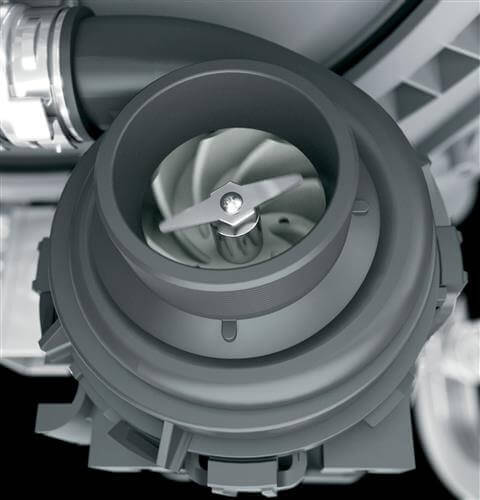
So basically, a food disposal blade grinds the food particles. The filters get fitted right below the food disposal blade so that small food particles accumulate on the filter.
7. Heated Dry
All dishwashers come with a heated dry option. What it does is it takes away the moisture from utensils and also sanitizes those.
A dishwasher has a heating element right below the bottom basket. The heating element is connected to the mainboard. When it the time for heated drying, the heating element gets heated up and dries the dishes.
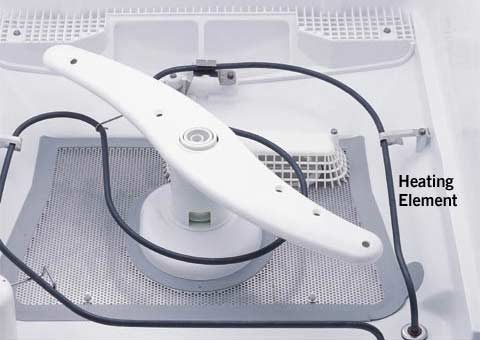
8. Control Panel
There are two types of control panels available in dishwashers based on where the control panel is located.
- Front Control Panel
- Top Control Panel
Front Control Panel
As the name suggests, the front control panels are located at the front of the dishwasher door. Usually, front control panels are found in low-cost dishwashers.
It usually has mechanical knobs to control the different functions of dishwashers. However, electronic touch controls are becoming very common. Portable dishwashers come mostly with a front control panel.
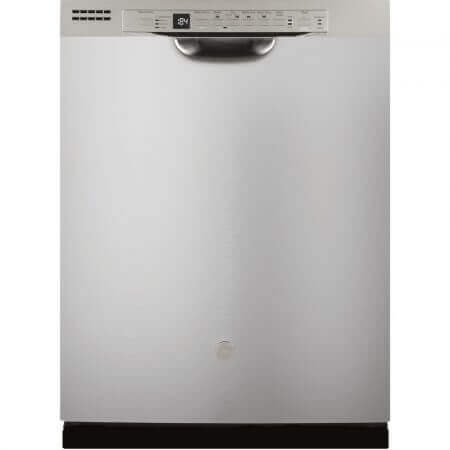
Top Control Panel / Hidden Control Panel
The top control panel is also called a hidden control panel as it gets hidden under the sink in the case of the built-in dishwasher.
It often comes with touch control or tactile buttons. This gives the dishwasher a premium look. As there are no clutters on the front of the dishwasher, it also adds elegance to your kitchen appearance.
Top control panels are common across the premium range of dishwashers.
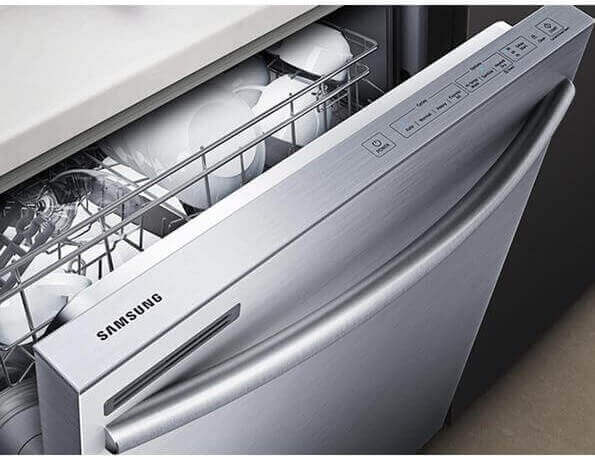
9. Handle / Without Handles
Many dishwashers come with handles, and many come with a groove on the front door. The functionality is the same, but the dishwasher with handles looks more premium and clutter-free. However, it is an individual preference on what type of configuration they like as per their requirement.
10. Auto Restart
In India, where we suffer from frequent power cuts, the auto-restart option is a blessing. Auto-restart starts the machine from where it was stopped before the power cut. So you don’t need to run the full cycle all over again. That saves a lot of water, power, and time, a must-have option in dishwashers for India.
11. Flood Sensor
This is a must-have sensor in all dishwashers. It senses the amount of water in the dishwasher and cuts off the water line if it feels that the water level is too high to cause a flood in your kitchen.
So if you see that water is leaking from the dishwasher, then you need to check this flood switch first for any issues.
12. Accordance With Hard Water
In India, we usually get hard water for daily washing and sanitary. Hard water is terrible for dishes and for dishwashers too.
Though some softeners are available in the market that can soften the hard water in the dishwashers, many dishwashers come with an inbuilt water softener feature that can sort out this hard water problem.
13. Noise
Although in India, Government regulations are not that strict when it comes to noise pollution, we must use appliances that create less noise.
Dishwashers use a special butadiene-based soundproofing canopy that helps to reduce the amount of noise going out.
But dishwashers are not silent machines. The noise level varies from 40 dB to 100 dB. The lesser the dB value, the more costly the dishwasher will be.
14. Child Lock
Safety is first. Right? And when it comes to kids, you should not make any compromises. Although the dishwasher will stop automatically if a kid opens the door accidentally, you can not control the water flow.
That is why most dishwashers come with a child lock feature that locks the control during the wash.
15. Spray Arms
The spray arm is one of the critical components of a dishwasher. It sprays water jets on utensils at a force.
Some water jets spray water in 2D directions, and some other spray arms pour water in a 3D direction. The 3D water jet is always better as it consumes less water and time to clean dishes. However, you need to pay a premium price for this.
Typically there are two arms if there are two racks. One spray arm is at the bottom of the lower rack, and another one is at the bottom of the top rack. If there is a third rack, an additional spray is also available in that dishwasher.
16. Wi-Fi Connectivity
We are living in the age of digitation. So having wi-fi in appliances is a common thing. Many dishwashers come with wi-fi functionalities through which you can control different functions of the dishwasher.
You can also start and stop or schedule the wash cycles from manufacturers’ smartphone apps.

Best Dishwasher Brands In India: Dishwasher Buying Guide
Although many brands in the market manufacture dishwashers in India, the following three brands are the best in product performance, pricing, reliability, and innovations.
Bosch
Bosch is known for making reliable products, and its dishwashers are truly solid. They have a wide range of dishwashers lined up and they constantly invest in innovation. Although a bit expensive, if you compare the feature-to-price ratio, Bosch dishwashers make more sense.
IFB
Although IFB is still trying to get footfall in the Indian market, the dishwasher is one of the products that make it stand tall in the crowd.
In terms of built quality, features, and pricing, they have an edge. However, if they improve the aesthetics, they have the potential to become the market leader.
LG
Be it a washing machine, refrigerator, or dishwasher, LG is everywhere. They are truly a global brand and have a solid portfolio in most of the appliance categories. If you are bothered about aesthetics and new innovative features, then you should buy LG dishwashers.
Dishwasher Use And Maintenance Tips
In India, we have a wrong perception that dishwashers can not clean dishes properly. Do you know that a dishwasher is considered an essential appliance in developed countries like The USA, and the UK?
In the USA, you won’t find a single home without a dishwasher. So if our perception is correct, then do you believe that they live with dirty utensils?
The problem is how we handle the dishwasher to get a proper cleaning. Like how we dump 10 KG of clothes in a 6 KG washing machine, we should not dump excessive dishes in a dishwasher. If you do so, no machine can give good cleaning.
Here is an excellent video explaining how to load containers in a dishwasher properly.
Here are the few points that you should take care of when you use a dishwasher
- Never overload your dishwasher. Overloading may not clean your dishes at all.
- Arrange the plates in such a way that water penetrates between plates.
- Always pre-wash your dishes before you dump them into the dishwasher.
- Make sure there are no food particles on your dishes.
- Always use both hot and cold water combinations for the best result.
- Never use thirty-party local dishwasher detergents.
- Clean dishwasher filters once every week.
- Check if the dish is dishwasher safe before putting that into the dishwasher.
- Use the proper cycle based on your load size and the level of dirtiness.
- Don’t block dishwasher vents with other appliances.
- Make sure that the dishwasher is grounded correctly to save you from electric shock.
- Check the drain pipe regularly for any clogging issues.
Conclusion: Dishwasher Buying Guide
Please don’t keep this misconception that dishwashers are fancy appliances meant for rich people. Instead of paying 2000-3000 per month to a maid, you can invest in a dishwasher, and you can save more in the long run.
Don’t forget that a dishwasher can sanitize your dishes whereas a maid can not.
I hope this article gave you enough insights into how a dishwasher works, the factors that you should consider while buying a dishwasher, and how to handle and properly use a dishwasher.
If you still have any questions, don’t hesitate to drop a comment in the comment section, and we will be happy to help.
You may also like to read: 10 Best Dishwashers In India
FAQ | Dishwasher Buying Guide
Why are dishwashers not so popular in India?
It’s because of the misconception that dishwashers can not clean dishes properly, which is not true. The main reason that a dishwasher does not perform well in Indian households is that we dump everything in the dishwasher.
If you do this, dishwasher filters get clogged, which affects the performance of the dishwasher. And we blame that the dishwasher is not good.
How do the dishwasher clean dishes?
Dishwasher clean dishes with a combination of mechanical, thermal, and chemical reactions.
The water jet creates mechanical force, the heating element generates heat, and detergent does a chemical reaction with the dirt to clean it. This is the basic principle.
What is called A “Dishwasher Safe” utensil?
Since dishwashers generate a lot of heat, all types of dishes are not good for dishwashers. For example, some plastic utensils will melt if you put them into the dishwasher.
So you should always buy dishwasher-safe utensils if you plan to clean them in a dishwasher.
Is it hygienic enough to wash my child’s milk bottles in the dishwasher?
Yes. A dishwasher is a better option for cleaning those utensils where you want them to be hygienic and sanitized.
How to remove stain marks on dishes after cleaning them in a dishwasher?
To make sure that your dishes do not catch any stain marks, you should consider using a good-quality rinsing agent. Also, make sure that it is manufacturer-recommended.
Why I am hearing some sounds from the dishwasher?
It is normal to get some sounds from the dishwasher. It is due to the water jet flooding the dishes. However, if you hear some loud sounds, then you need to call a technician.